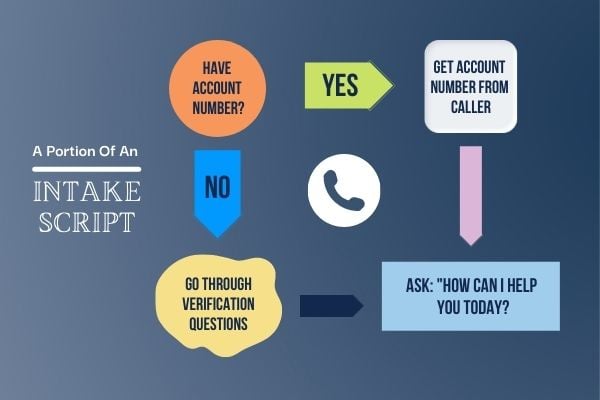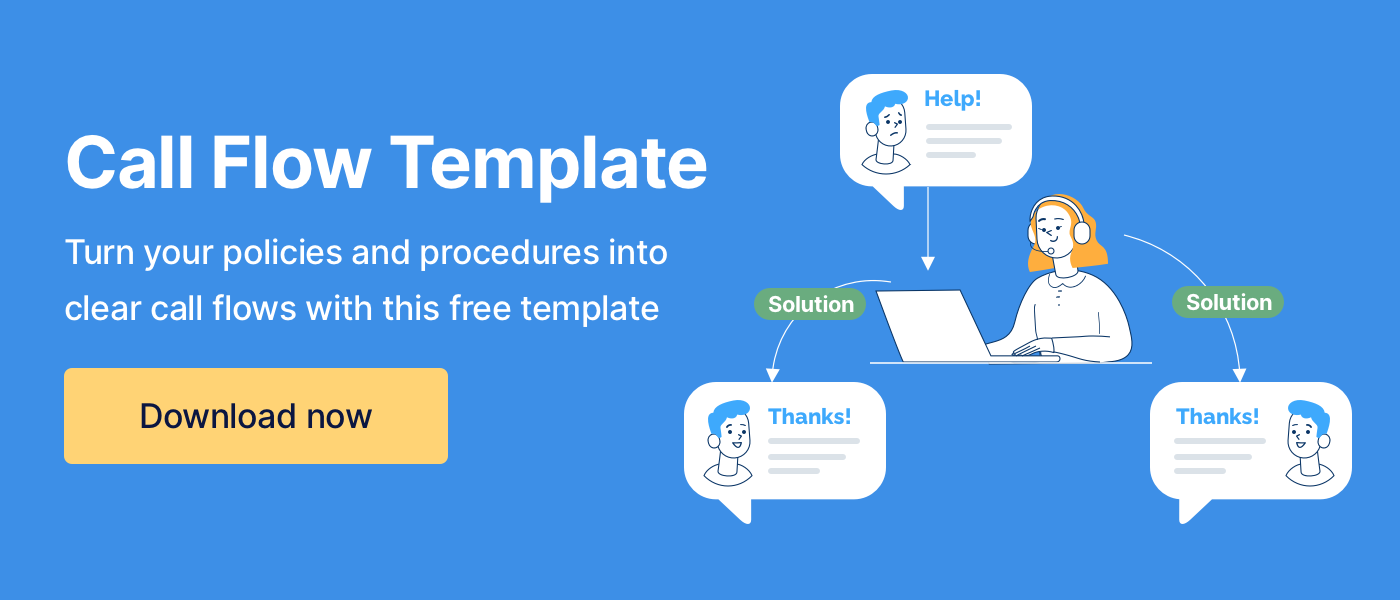One movie quote that gets a lot of life with my friends and family comes from a Shakespearian knock-off film from the early 2000s, She’s the Man.
In one scene, Viola, the female heroine who is posing as a guy, helps her guy friend prepare for what to say on a date with his crush. The advice is used frequently amongst my family and friends when we don’t know what to say.
.gif?width=480&height=235&name=%23%20Types%20of%20Call%20Center%20Call%20Flows%20(+%20Examples).gif)
While this cheesy line might make you cringe, it works because it was a plan for what to say. It served as a prompt to start a conversation.
In a call center, you want to provide your call center agents with prompts on what to say and do. Those are called call flows. A call flow is anything that is going to help a rep navigate a call.
And while they are more complex than my She’s the Man example, the concept works. If you provide your agents a path forward, it helps them get unstuck.
Working for ScreenSteps — a knowledge base software company that helps call centers write clear call flows — I’ve seen how agents make fewer mistakes when they have concise call flows that fully cover different situations.
In this article, I’ll show you seven different types of scenarios where you can create call flows to support your call center agents. Then I’ll provide examples so that you can brainstorm which types of call flows you could write for your call center.
Note: There are three different approaches to writing call flows: standard articles, flowcharts, and workflow articles. The examples below cover all of these design elements. If you want to learn more, read this article about your call flow design options.
1. Inbound call flow
An inbound call flow is the prompt a call center agent follows when someone calls into a call center. These callers have voluntarily reached out to your organization.
Typical situations for inbound calls include a customer calling about an issue, customers paying a bill, prospective customers asking for information about services and products.
2. Outbound call flow
An outbound call flow is the opposite of an inbound call flow. With an outbound call flow, your agents are reaching out to customers and prospective clients. The outbound call flow is the outline of what your agents need to say and do on a call.
When a customer picks up a call, an outbound call flow tells the agent what to say and ask first.
This is often used for cold calling or follow-up calls on people requesting information. Outbound call flows are commonly used in sales, telemarketing, collections, fundraising, and other outreach activities.
3. Intake call flow
An intake call flow directs the first words and actions that an agent takes on a call. Whether it is an inbound or outbound call, an intake call flow is what helps direct the caller to the appropriate agent who can help them.
The goal of an intake call flow is to gather information, identify the purpose of the call, and help the caller reach a resolution as quickly as possible by properly directing the call. This could mean transferring the call or moving into a call flow to handle the caller’s specific situation.
Intake call flows help your call center be more efficient.

🔍 Related: How to Write an Intake Script for Scheduling Patients (6 Tips)
4. Troubleshooting call flow
Once an agent has gone through the intake call flow, they either transfer them to the appropriate agent or proceed to another call flow for the scenario. One of those scenarios is if it is a troubleshooting call.
A troubleshooting call flow is used to help an agent resolve an issue with a product or service. These call flows are used to help customers who are calling in with problems.
Maybe their internet isn’t working and they need to figure out why. Or they are being charged extra on their bill and they are trying to figure out why.
A troubleshooting call flow provides the most efficient path for a call center agent to work with the caller to discover the root of the problem and resolve the issue.
That means it starts with the most common causes of a given problem/situation. Then it leads the call center rep into other options until they’ve exhausted their options and the issue is resolved.
5. Compliance and regulated procedure scripts
Call flows are not scripts for your agents. They are prompts. However, there may be situations where you would want to include a script in your call flow.
If you have specific phrasing and verbiage for compliance, you would want to include a script. Or, if you have some other regulated procedure, you would want to include a script to ensure things are done correctly.
Note: All of these different types of call flows can include script elements if your call flow tool allows you to include more text. Learn more about when to use call flows and scripts here.
6. Complex process call flow
Complex processes are usually easy to identify because they are difficult to resolve and you want to use the “if/then” statements. For example, “If this is happening, then try this.”
They typically have a lot of decision trees that have multiple branches or paths they can take. That’s because complex processes and procedures have a lot of possible outcomes. A call flow for a complex process needs to cover all of those outcomes.
7. Closing call flow
When your agents are done with a call, what do they do? What do they say?
A closing call flow helps you wrap up a call and ensure that your agent has achieved one call resolution.
Closing call flows can be simple, include branding, and provide a checkpoint to make sure you are providing excellent customer service.
It is your final touchpoint with the customer. You want to keep the closing short and to the point.
Create call flows for every situation in your call center
There are many different types of call flows, but all call flows have one purpose — to aid call center agents so that they can be efficient and avoid mistakes.
At ScreenSteps, you provide simple yet powerful call flow authoring tools so that you can quickly and clearly create call flows. Plus, our knowledge base software makes it easy for you to update your call flows so they are never out of date.
Agents can find these call flows in as few as two clicks so that they don’t need to put a caller on hold.
What type of call flows do you need for your call center? Make a list of the call flows you need to write for your call center.
Need help? Download this free call flow workbook to help you brainstorm what type of call flows you need to create for your call center. It will help you outline your call flows.




